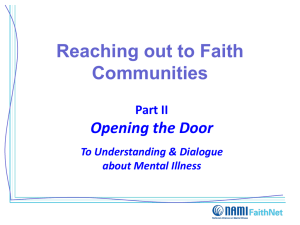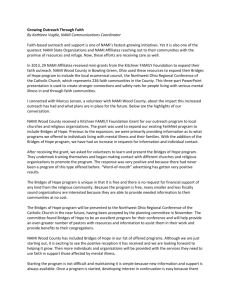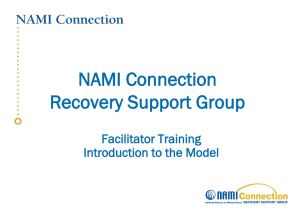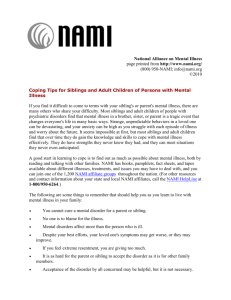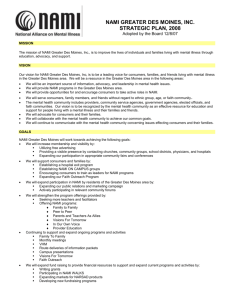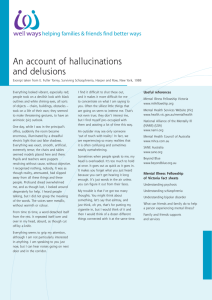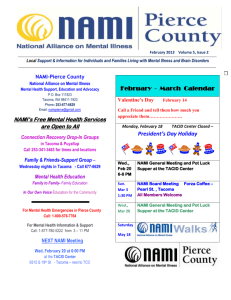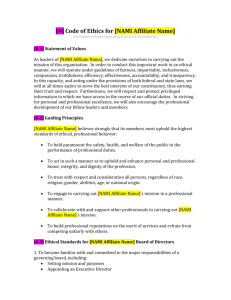Presentation Script
advertisement
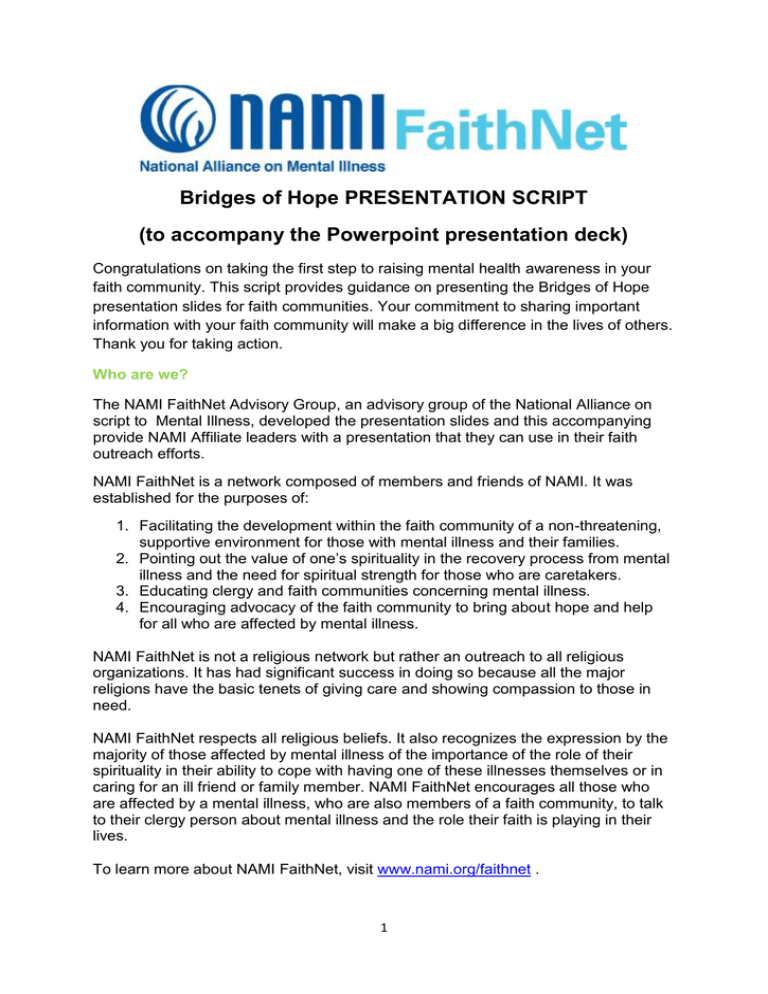
Bridges of Hope PRESENTATION SCRIPT (to accompany the Powerpoint presentation deck) Congratulations on taking the first step to raising mental health awareness in your faith community. This script provides guidance on presenting the Bridges of Hope presentation slides for faith communities. Your commitment to sharing important information with your faith community will make a big difference in the lives of others. Thank you for taking action. Who are we? The NAMI FaithNet Advisory Group, an advisory group of the National Alliance on script to Mental Illness, developed the presentation slides and this accompanying provide NAMI Affiliate leaders with a presentation that they can use in their faith outreach efforts. NAMI FaithNet is a network composed of members and friends of NAMI. It was established for the purposes of: 1. Facilitating the development within the faith community of a non-threatening, supportive environment for those with mental illness and their families. 2. Pointing out the value of one’s spirituality in the recovery process from mental illness and the need for spiritual strength for those who are caretakers. 3. Educating clergy and faith communities concerning mental illness. 4. Encouraging advocacy of the faith community to bring about hope and help for all who are affected by mental illness. NAMI FaithNet is not a religious network but rather an outreach to all religious organizations. It has had significant success in doing so because all the major religions have the basic tenets of giving care and showing compassion to those in need. NAMI FaithNet respects all religious beliefs. It also recognizes the expression by the majority of those affected by mental illness of the importance of the role of their spirituality in their ability to cope with having one of these illnesses themselves or in caring for an ill friend or family member. NAMI FaithNet encourages all those who are affected by a mental illness, who are also members of a faith community, to talk to their clergy person about mental illness and the role their faith is playing in their lives. To learn more about NAMI FaithNet, visit www.nami.org/faithnet . 1 How should you use this guide? This guide walks you through the Bridges of Hope presentation slides. It covers key points to make for each slide, suggested transitions from one slide to the next and discussion prompt options you can choose from to engage participants throughout the presentation. You should pick and choose the discussion prompts that work best in your presentation. IMPORTANT NOTE: Try to connect the general information included in the slides and this guide to your specific faith group and to the people who will be attending the presentation by using anecdotes, examples and data from your community. Who can do the presentation? Who should you partner with? The slides and this guide can be used by individuals from your faith group, NAMI Affiliate, and other leaders. You may wish to partner with others in doing the presentation, although this is not required. Here are a few people you may wish to reach out to: Your community health care professionals. This includes psychologists, psychiatrists, nurses, counselors and other health care providers available in your faith community who may be interested in the presentation. People in your community living with a mental health condition. They can talk about their experiences living with a mental health condition, including the early warning signs they experienced, how and why they got help and what services and supports helped them the most. Another representative from your NAMI Affiliate. A NAMI Affiliate in your community can provide information on resources and help facilitate the discussion. To find contact information for your NAMI Affiliate, visit www.nami.org/local . Spiritual leaders. Reach out to prominent leaders in your faith group, such as your priest, rabbi, imam or monk or other faith community leaders. Other organizations and groups. You may want to include other organizations and groups that can offer unique perspectives on specific issues. These can include groups that represent veterans or others from culturally and racially diverse groups. What should you do to prepare for the presentation ? Here is a quick checklist to go through as you prepare for the presentation : Download the PDF presentation slides to your laptop or put on a flash drive. Make sure the slides display correctly and that everything works. 2 Setup an LCD projector to display the presentation. Practice the presentation to ensure you can cover all of the material within the timeframe available. Make adjustments to length as necessary . You may wish to create a slide or handout that includes information about your community’s services and supports. As mentioned earlier, contact anyone you may like to have present with you during the presentation . One last note … The last slide of the presentation includes a link to five short questions answer about the presentation. The link is https://www.surveymonkey.com/s/bridgesofhope. Please encourage everyone to respond to these important questions. Their responses will help inform additional efforts related to faith group mental health. They will also help ensure that faith groups across the country have the resources they need to make a difference and to take action on their communities. Thank you for your help in collecting this important information. Guidance on the Presentation Slides This section outlines key points to make for each slide, discussion prompt options to encourage interaction throughout the presentation and suggested language to transition from one slide to the next. This presentation assumes you have about an hour available to present the information and interact with the participants. You should choose which discussion prompts you would like to use and have time for before doing the presentation. It is best to go through this guide while viewing the slides to become more familiar with the presentation. Slide 1 ______________________________________________________ Key Points (Note to Speaker: Introduce yourself with your name, your volunteer or staff position and the name of your local NAMI Affiliate.) Thank you for this opportunity to speak with you about Bridges of Hope: Faith Communities and NAMI. Today, we’ll examine the troubled waters of mental illness and two strong bridges which have helped many people and families navigate the deep waters of mood and thought disorders. These bridges of hope are faith communities and NAMI (the National Alliance on Mental Illness). Mental health affects everyone. Slide 2 ______________________________________________________ 3 During our time together, we plan to answer three main questions. What is mental illness and its impact on individuals, the family and our community? Second, what is the role of the faith community? Finally, who is NAMI and what does it offer? If we recognize mental illnesses and the major problems they pose for people, then we can be helpful. But many congregations don’t know how to help – perhaps due to fear or lack of knowledge. So, we want you to know about how NAMI can provide another bridge to strong advocacy, education and support programs of NAMI. Slide 3 ______________________________________________________ Many individuals and families do not recognize the early signs of unusual behavior, thoughts or moods as a treatable biologically-based brain disorder. So, if the mental illness goes untreated, it can turn into a rushing torrent, sweeping away the affected person’s ability to live a normal healthy life. (Note to speaker: If possible, have someone share a 2-3 minute story about their journey with mental illness – either their own or that of a loved one. If you cannot find someone else, either give your own story or use the script below. Skip to slide 4, if using a short story.) One NAMI family described their experience this way. When things were at their worst, it seemed like the illness was in control, and that our entire family life was being pulled under. We were all overwhelmed and helpless. We felt stranded and alone on the shore as it seemed our son was being swept away by schizophrenia, out of reach and forever lost to us as the person we had known. We felt helpless to help him, and knew no one to explain what was happening. Slide 4 ______________________________________________________ Even today, despite all the advances in research and treatment options, there are still people who know too little or nothing about serious mental illness and community resources. They may struggle themselves or know others who suffer. But there are so many other ways to help if we only know how. Too many moms, dads, veterans, youth, boys and girls affected by a mental health condition simply drift away, caught in the rapids of emotional and mental torment. Families are often torn apart. Lives are wasted or lost. Slide 5 ______________________________________________________ 4 Coping with a mental illness can be bad enough, but trying to get proper treatment is even more difficult, especially if you don’t have adequate health coverage or have no advocate to help you overcome barriers to treatment. This is unacceptable in times of plenty …and disastrous in the current economic environment. Many individuals still find limited resources and broken connections between health care providers, housing assistance and social services. Before we go further, let’s be clear about what we mean by mental illnesses. Slide 6 ______________________________________________________ First and foremost, they are medical conditions, health conditions that disrupt a person's thinking, moods, ability to relate to others and perform daily functions. Just as diabetes is a disorder of the pancreas, mental illnesses are conditions that can result in diminished capacity for coping with the ordinary demands of life. Much about the cause of mental illness is unclear, but researchers believe they are the result of a combination of environmental and biological factors. Serious mental illnesses include major depression, schizophrenia, bipolar disorder, obsessive compulsive disorder (OCD), panic disorder, post traumatic stress disorder (PTSD) and borderline personality disorder. They can affect persons of any age, race, religion or income. They are not the result of personal weakness, lack of character or poor upbringing. Untreated, they can have serious long-term consequences. They are treatable. Most people diagnosed with a mental illness can experience at least some degree of relief from their symptoms by participating in an individualized treatment plan. Many regain a productive life. There is hope and help, now. Slide 7 ______________________________________________________ I imagine we can agree that everyone experiences wide ranges of sadness and happiness, elation and sorrow throughout their life. Mental and emotional swings are simply part of being human. So, how do we know when we or someone we know might be experiencing a serious medical condition that is causing a thought or mood disorder? Though we shouldn’t try to diagnose anyone, it is helpful to know some of the Red Flags that may hint at the possibility of serious mental illness. 5 Slide 8 ______________________________________________________ According to the American Psychiatric Association, there are ten warning signs of a serious mental illness. They are • a marked personality change, • an inability to cope with problems and daily activities, • strange or grandiose ideas, • excessive anxiety, • prolonged depression or apathy, … Slide 9 ______________________________________________________ …marked changes in eating or sleeping patterns, thinking or talking about suicide, extreme emotional highs and lows, abuse of alcohol or drugs, excessive anger, hostility or violent behavior. If a person displays one or more of these warning signs consistently over a two week period, they should be evaluated by a psychiatrist or other physician as soon as possible. It won’t help to tell them to “get their act together” if they truly have a mental health condition any more than telling someone with a broken leg to walk. Does this help clarify the difference between normal and abnormal mood and thought disorders? Slide 10 ______________________________________________________ By now, perhaps you are thinking, “How common is mental illness? I never hear anyone talking about it in my congregation.” If we consider faith communities to be microcosms of the larger population, the facts on the screen will relate to the prevalence of mood and thought disorders in your congregation. One in four adults experiences a mental health condition in any given year, including our veterans and military members. (1) 6 About one in 17 lives with a serious mental illness, such as schizophrenia, major depression or bipolar disorder (2) 26% of the homeless population lives with a serious mental illness. (3) 1. National Institute of Mental Health, The Numbers Count: Mental Disorders in America, 2006 (rev). 2. Ibid. 3 Hunger and Homelessness Survey, A Status Report on Hunger and Homelessness in America's Cities, The U.S. Conference of Mayors, (December 2008). Slide 11 ______________________________________________________ And if that were not bad enough, • About 20-25 percent of jail and prison inmates and youth involved with juvenile justice live with serious mental illness (4,5) • We lose one life to suicide every 15.8 minutes.(6) People of faith are not immune to the terminal trauma that untreated mental illness can lead to. 4. U.S. Department of Justice, Office of Justice Programs, Bureau of Justice Statistics Special Report. Mental Health Problems of Prison and Jail Inmates. September 2006. NCJ 213600. Accessible at http://www.ojp.usdoj.gov/bjs/abstract/mhppji.htm. 5. National Center for Mental Health and Juvenile Justice. Blueprint for Change: A Comprehensive Model for the Identification and Treatment of Youth with Mental Health Needs in Contact with the Juvenile Justice System. 2007. Accessible at http://www.ncmhjj.com/Blueprint/default.shtml. 6. McIntosh, J. L. (for the American Association of Suicideology). (2009). U.S.A. suicide 2006: Official final data. Washington, DC: American Association of Suicideology, downloaded from http://www.suicidology.org. Slide 12 ______________________________________________________ The prevalence of mental health conditions in children and adolescents is also significant and on the rise. About 1 in 10 children in the U.S. lives with a mental illness severe enough to cause poor social skills, learning difficulties, school failure and higher school drop-out rates.(7) About half of students with a serious mental illness in special education drop out of high school—the highest dropout rate of any disability group. Research shows that early diagnosis and treatment of children with serious mood or thought disorders significantly improves their long-term chances for success. 7 7. The National Advisory Mental Health Council Workgroup on Child and Adolescent Mental Health Intervention Development and Deployment. “Blueprint for Change: Research on Child and Adolescent Mental Health.” 2001. Slide 13 ______________________________________________________ Just as in the case of other serious and chronic illnesses, mental health conditions often pose a major challenge to our faith. Perhaps you or someone you know has asked … Where is God? Why do bad things happen to good people? What have we done wrong? How can my faith help? What’s next? What is the meaning of all this turmoil? Where do I belong? Mental illness often tests our faith and may profoundly impact our spiritual journey, either positively or negatively. Slide 14 ______________________________________________________ Mental illness can also cause feelings of spiritual isolation and estrangement. Individuals and their families caught in the turmoil of serious mental illnesses are often the loneliest and most estranged members of our neighborhoods and communities. Imagine what it’s like to be a child whose profoundly depressed mother does not respond at all to a simple, “Look what I did in school today,” or who suddenly switches moods, talking non-stop nonsense for thirty-six hours, and then disappears for months because she has to endure a hospitalization. Imagine what it’s like to be told by your father, before he goes to work each day, to keep an eye on your mother who is at risk for suicide when you get home from school – but he is so preoccupied that he never really explains what is going on, never asks how you are doing, and neither does anyone else. Imagine what it’s like for a homeless young man who comes late at night to sleep in the doorway of the synagogue. He leaves early in the morning before anyone knows he is there. Then one day, exhausted, he sleeps late and is awakened by a custodian. The young man cringes, tired, tearful, sad, ashamed. 8 Slide 15 ______________________________________________________ The good news is that mental illnesses are treatable and that people can regain wellness in their lives – thanks to advancements in brain research and the development of better treatment and services. Everyone responds differently to various treatment options, but for about 75% of people with depression, schizophrenia, severe anxiety disorders and bipolar disorder, treatment works – to varying degrees! What treatment options are you familiar with? Remember: 1) A thorough physical exam to preclude any conditions that can mimic a mental illness. 2) An evaluation by a psychiatrist who may recommend further tests or a treatment regimen, or in a crisis, temporary hospitalization. 3) Individual or group therapy or counseling by a certified mental health counselor. 4) Supportive services by a professional social worker. 5) Education about the illness for the individual, family and friends. 6) And of course, healthy eating, sleeping and exercise habits and other health interventions. Slide 16 ______________________________________________________ We’ve covered a lot of ground, so before we go on to explore the role of the faith community, does anyone have a burning question? Slide 17 ______________________________________________________ Faith communities are in a unique position to help people affected by mental illness, the individuals and their families. Let’s look at some factors that give faith communities the edge on being supportive and helpful in this area. Slide 18 ______________________________________________________ • First of all, clergy are often the first person many turn to for help when they are in distress. They are usually on the front lines of mental and emotional crises, but few clergy feel prepared to respond effectively to those experiencing a mental health crisis. 9 • Furthermore, churches, temples, mosques and other faith communities are more numerous than mental health care providers, and they are more evenly distributed geographically. Faith groups already provide educational settings, so a larger percentage of Americans can gain awareness and get the help they need. Faith groups are often already committed to social justice issues and advocacy for the marginalized, poor and oppressed in society. • For many individuals affected by mental illness, faith is a key component in their recovery. Slide 19 ______________________________________________________ Putting it simply, congregations provide a place to belong and experience hope. By learning about mental illness and the role of treatment and support, people of faith can more pro-actively support individuals and their families. They can help maximize a person’s recovery potential. So, how do faith communities do that? How can they provide a bridge of hope and a place to belong? Slide 20 ______________________________________________________ Let me give you an example from Ellyn Saks, a lawyer and professor of psychology at the University of Southern California who also lives with schizophrenia. She describes in her book The Center Cannot Hold how, when she had cancer, she was visited in the hospital and supported in her recovery with….. (Click left column bullets.) She then contrasts that with what happened when she was hospitalized for schizophrenia. She was alone in her recovery. (Click right bullet points) She had no visits, cards, meals, prayers, support or welcome back. Of course, we need to be sensitive to a person’s desire for privacy, but these simple acts of love let the person know we care and miss them when they are absent –no matter what kind of illness they have. 10 Slide 21 ______________________________________________________ But these underlying elements of basic care for people with mental illness will make the cards, meals and phone calls much more appreciated. Learning to recognize the illness and accept the person just as they are is fundamental. That may take effort on our part, but care and concern may be misdirected if we don’t understand the kind of illness they have. Second, assist in finding the help needed. Perhaps that’s providing a list of social services and mental health care providers. Your NAMI Affiliate may already have such a list. Third, we need to make it clear from the pulpit and in all teaching settings that we support medical treatment and counseling in addition to prayer and spiritual practices. If people feel judged for having a problem, they won’t choose to seek help. Fourth, we must attend to the individual’s basic needs—like a coat, shelter, a meal or transportation to the doctor. This is often the door to nurturing their spiritual growth. Slide 22 ______________________________________________________ After the basic physical and medical needs of a person are met, there is a deeper level of spiritual support and care that often gets over-looked. The gift of presence requires that we avoid doing for them what they can do for themselves, giving advice, or pushing our own agenda. As we listen and share the journey, we ask honest, open questions that will help them express their goals, as well as what they need and want. And, let’s not underestimate the power of prayer support. One woman, after being told by a hospital Chaplain on a Friday that he pray for her over the weekend, told him on Monday how much better she felt on Saturday and Sunday mornings just knowing someone was praying for her. Slide 23 ______________________________________________________ Mental Illnesses impact the family as well as individual. So, faith groups may need to make a concerted effort to reach out to these families. We need to learn about the illnesses and the specific needs of the parent, spouse or child. 11 But most often families just need someone who will walk across that bridge and be a friend—especially when their loved one goes off their medications or community services fall short. Learn what is helpful or hurtful to say or not say. Can you give an example of a helpful or hurtful remark? (Speaker note: allow a 5 min. discussion.) As we said before, offering information about community mental health resources is often needed and appreciated. Slide 24 ______________________________________________________ We’ve talked about practical and spiritual care. Now let’s explore ways we can educate and raise awareness in the congregation on a regular basis. Are you familiar with the national awareness seasons during which we can help break the silence and shame associated with mental illnesses? May is Mental Health Month. July – Minority Mental Health Month The first week of October is Mental Illness Awareness Week. Tuesday of that week is the National Day of Prayer for Mental Illness Recovery and Understanding. Slide 25 ______________________________________________________ Choose just one or two activities at first to observe a National Mental Health month or day. You could… • Write an article for your congregation’s newsletter or bulletin. • Compose a prayer, a poem or song to share in a service, small group or adult education class. • Schedule a speaker from NAMI or a mental health professional. • Invite members of your faith community to participate in your NAMI WALK. • Create a bulletin board. The possibilities are numerous. 12 If you are interested in downloadable resources, check out the NAMI FaithNet resources at www.nami.org/faithnet. Slide 26 ______________________________________________________ Before we go on, let’s relate this to your congregation. What is your (church, synagogue, temple) already doing to provide a bridge of hope for people touched by mental illness? What would you like to see it do? What are you willing to help with? What other ideas might you have? (Speaker: Facilitate a 6-8 minute discussion; encourage the group to pick 2-3 activities from the previous slide to follow through with. Ask for 2-3 volunteers to steer the effort. After a short discussion, continue with the following.) These types of awareness activities for the entire congregation truly bring hope to families and individuals who feel isolated by their illness. And did you know that giving support is exactly how the story of NAMI began in the late 1970s? Slide 27 ______________________________________________________ You might say, NAMI become a Bridge of Hope for several women whose mutual support changed their lives. Harriet Shetler’s son was diagnosed with schizophrenia. When she shared her anxiety with a friend in her church, this friend put her in touch with another member of the congregation, Beverly Young. Beverly faced similar challenges with her own son who had a mental illness. Harriet and Beverly met for lunch in 1977 for mutual support and within six months, their efforts brought together 75 people. AMI – the Alliance for the Mentally Ill, an early chapter in NAMI’s life, was formed in Madison Wisconsin. Things haven’t been the same since for her and thousands of other NAMI members!! Slide 28 ______________________________________________________ Now, almost 35 years later, NAMI is the largest, most influential grassroots, self-help advocacy organization in the US. We are dedicated to improving the lives of people affected by mental illnesses through education, advocacy, support and research. 13 NAMI actually is three organizations, with local NAMI Affiliates working with and in concert with NAMI State organizations, who, in turn, work with the national NAMI. NAMI programs are different from those of many other advocacy organizations because they are based on the peer-led, lived-experience approach. While many NAMI members are mental health professionals, friends and supporters, the majority of our members are family members and persons themselves who have navigated the tumultuous seas of mental illness and are living productive lives. Slide 29 ______________________________________________________ All our NAMI signature programs are offered at no expense to participants. Here are just a few of them. NAMI Family-to-Family is a 12-week course for family and care-givers of those living with a brain disorder. NAMI Basics is an 8-session course for family caregivers of children and youth affected by mental health conditions. NAMI Connection is a peer-led recovery support group that meets regularly for persons who have a diagnosis of mental illness. NAMI Family Support groups offer mutual encouragement and support to family and friends of those living with mental illness. NAMI Peer-to-Peer is an 8-week course for persons who live with a diagnosis but are stable and ready to take responsibility for their recovery. …and there are many others we don’t have time to describe. One of the greatest benefits of all our NAMI programs is that people discover they are not alone; someone else understands. Slide 30 ______________________________________________________ Your closest NAMI Affiliate is _________________. The contact information is here on the slide. Later, as you leave we hope you’ll pick up a NAMI brochure. (Notes to speaker: Prior to this presentation, fill in the top box of the slide above with the name and contact information for the nearest local NAMI affiliate. In the lower box, delete any of the NAMI programs not provided by that Affiliate. Pre-arrange for someone to give a 2-3 minute testimonial about the value of the NAMI programs they have benefitted from, such as NAMI Family-to-Family, NAMI Peer-to-Peer or a support group or other. 14 As an alternative, you may use the story and slide at the end of this presentation entitled “NAMI & Faith Communities: Building Bridges of Hope”. It follows the blank slide, and can be moved from the end to the position following this slide. As people leave later, provide brochures and information about the local NAMI Affiliate to your listeners.) Slide 31 ______________________________________________________ The Bridge of Hope your faith community builds will look different from that built by other organizations and faith groups. Untreated mental illnesses can be challenging and destructive – for individuals, for people of faith, for families and for society in general. But our Bridges of Hope can span the destructive forces of mental illness when we combine our resources with those of mental health providers and community organizations like NAMI. The important thing is that people around you living with mental illness know that they are not alone, that someone can help them over the tumultuous waters of serious mental illness and into a community of care and spiritual nurture. Slide 32 ______________________________________________________ We all need to be reminded of something Rosalynn Carter said: You can make a difference. People with mental problems are our neighbors. They are members of our congregations, members of our families; they are everywhere in this country. If we ignore their cries for help, we will be continuing to participate in the anguish from which those cries of help come. A problem of this magnitude will not go away. Because it will not go away, and because of our spiritual commitments, we are compelled to take action.“ −Rosalynn Carter Slide 33 ______________________________________________________ The NAMI website and HelpLine will connect you with a wide range of information that we’ve not had time to cover today. We don’t need to be experts. None of us knows all the answers. We simply need to know what and where resources are available. Thank you for the opportunity to speak today. We have a few more minutes. Is there anything we’ve covered that you have a question or comment about? (Speaker Note: After discussion, remind attendees as they leave to pick up the NAMI affiliate brochure and any other handouts you may have brought.) 15 Slide 34 ______________________________________________________ (Speaker Note: The End. Slide 35 is an optional slide, a testimonial about the value of NAMI Family-to-Family. It can be used in place of the testimonial on slide 30. Slides 36 and 37 that follow are simply additional information if your audience asks questions at the end of the presentation related to the topics on them. Slide 35 ______________________________________________________ Here is one NAMI family’s hopeful story. “It was 10 years from the time our son first showed abnormal behavior until he was adequately diagnosed and treated. That was after we found a NAMI support group and the NAMI Family-to-Family education course. Through NAMI Family-to-Family, we learned that depression, bipolar disorder, schizophrenia, anxiety disorders and obsessive-compulsive disorder are biologically based and treatable. We also learned that recovery is possible. We finally could hope for a fuller, more meaningful life for our son and family.” NAMI has become the Bridge of Hope for this family and many others. Slide 36 ______________________________________________________ Sometimes persons living with a mental illness may experience a psychiatric crisis, in which case it is imperative to get him or her into treatment as quickly as possible. If they are in imminent danger of hurting themselves or someone else, you can take one of two courses of action. If they are cooperative and desire help, and already have a psychiatrist, call their psychiatrist’s emergency number. If they do not have a psychiatrist, call your nearest community mental health center’s emergency access line. Describe the behaviors which are most concerning. If you cannot get an appointment immediately, take the ill person to the nearest hospital. Hopefully they will have a separate Psychiatric Emergency Room, but if not, tell the admitting nurse the nature of the illness. Ask if there is a separate quieter waiting area. Too much bustle and excitement can make an ill person more upset and want to leave rather than wait. If they are not cooperative, you may need to call 911 and ask for a C.I.T. officer, if your community has Crisis Intervention Trained officers. Make sure you tell the dispatcher that this is a psychiatric emergency. Some cities have a mental health mobile crisis unit. C.I.T. officers have received 40 hours of training to recognize and 16 de-escalate a mental health crisis. Their goal is to prevent further harm to anyone and get the person into treatment, rather than jail. If your family member has a history of mental illness, make sure you inform the dispatcher of this fact, and that this is a psychiatric emergency. Slide 37 ______________________________________________________ These are other mental health ministry links available from our NAMI FaithNet web site. Slide 38 ______________________________________________________ Please take a moment to complete this short three minute survey. Tell us how well Bridges of Hope worked for you or how you adapted the materials. On this form, you may also include your suggestions for building stronger relationships with faith communities. What outreach methods worked well in your area? This kind of information sharing will help us develop resources and tools that are practical and pertinent. Your feedback is essential to helping NAMI members be more effective advocates and educators in outreach to faith communities. Thank you! 17
